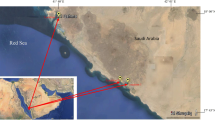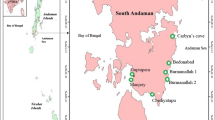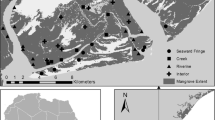Abstract
Soils from intertidal mudflats of mangrove dominated Indian Sundarbans were analyzed for soil organic carbon, bulk density and organic carbon density during 2009 in two different sectors: western and eastern. Samplings were carried out at 12 stations in four different depths (0.01–0.10, 0.10–0.20, 0.20–0.30 and 0.30–0.40 m) through three seasons (pre-monsoon, monsoon and post-monsoon). High organic carbon density is observed in the stations of western Indian Sundarbans, which is relatively close to the highly urbanized city of Kolkata, Howrah and the newly emerging Haldia port-cum-industrial complex. The mangrove forest in the eastern Indian Sundarbans exhibits comparatively lower organic carbon density. Anthropogenic activities are almost negligible in this sector because of its location almost within the protected forest area. The bulk density of the mangrove soil increased with depth, while organic carbon and carbon density decreased with depth almost in all the stations. We observed significant spatial variations in soil organic carbon and organic carbon density in the study area.









Similar content being viewed by others
References
Murako D (2004) Seaweed resources as a source of carbon fixation. Bull Fish Res Agency 1:59–63
Anthropogenic carbon fluxes; 1980 to 1989. IPCC 1994
Siegenthaler U, Sarmiento JL (1993) Atmospheric carbon dioxide and the ocean. Nature 365:119–125
Mitsch WJ, Gosselink JG (2000) Wetlands. Wiley, New York, pp 920
Cerón-Bretón JG, Cerón-Bretón RM, Guerra-Santos JJ, Aguilar-Ucán C, Montalvo-Romero C, Vargas-Cáliz C, Córdova-Quiroz V, Jiménez-Corzo R (2010) Effects of simulated tropospheric ozone on nutrients levels and photosynthethic pigments concentrations of three mangrove species. WSEAS Trans Environ Dev 6(2):133–143
Bridgham SD, Megonigal JP, Keller JK, Bliss NB, Trettin C (2006) The carbon balance of North American wetlands. Wetlands 26:889–916
Vesterdal L, Ritter E, Gundersen P (2002) Change in soil organic carbon following afforestation of former arable land. For Ecol Manag 162:137–147
Zinn YL, Lala R, Resck DVS (2005) Changes in soil organic carbon stocks under agriculture in Brazil. Soil Tillage Res 84:28–40
Homann PS, Remillard SM, Harmon ME, Bormann BT (2004) Carbon storage in coarse and fine fractions of Pacific Northwest old growth forest soils. Soil Sci Soc Am J 68:2023–2030
Shukla MK, Lal R (2005) Erosional effects on soil organic carbon stock in an on-farm study on Alfisols in west central Ohio. Soil Tillage Res 81:173–181
Jobb´agy EG, Jackson RB (2000) The vertical distribution of soil organic carbon and its relation to climate and vegetation. Ecol Appl 10:423–436
Wang SQ, Huang M, Shao XM, Mickler RA, Li KR, Ji JJ (2004) Vertical distribution of soil organic carbon in China. Environ Manag 33(Suppl 1):S200–S209
Mi N, Wang SQ, Liu JY, Yu GR, Zhang WJ, Jobb´agy EG (2008) Soil inorganic carbon storage pattern in China. Global Change Biol 14:2380–2387
Jackson RB, Schenk HJ, Jobb´agy EG, Canadell J, Colello GD, Dickinson RE, Field CB, Friedlingstein P, Heimann M, Hibbard K, Kicklighter DW, Kleidon A, Neilson RP, Parton WJ, Sala OE, Sykes MT (2000) Belowground consequences of vegetation change and their treatment in models. Ecol Appl 10:470–483
Gill R, Burke IC, Milchunas DG, Lauenroth WK (1999) Relationship between root biomass and soil organic matter pools in the short-grass steppe of Eastern Colorado. Ecosystems 2:226–236
Meersmans J, van Wesemael B, De Ridder F, Fallas Dotti M, De Baets S, Van Molle M (2009) Changes in organic carbon distribution with depth in agricultural soils in Northern Belgium, 1960–2006. Global Change Biol 15:2739–2750
Fontaine S, Barot S, Barre P, Bdioui N, Mary B, Rumpel C (2007) Stability of organic carbon in deep soil layers controlled by fresh carbon supply. Nature 450:277–280
Mitra A (2000) In: Sheppard C (ed) Seas at the millennium—an environmental evaluation, Chapter 62. The Northeast coast of the Bay of Bengal and deltaic Sundarbans. Elsevier Science, New York, pp 143–157
Chaudhuri AB, Choudhury A (1994) Mangroves of the Sundarbans—India, 1st edn. IUCN, The World Conservation Union, Dhaka
Ovalle ARC, Rezende CE, Lacerda LD, Silva CAR (1990) Factors affecting the hydrochemistry of a mangrove tidal creek, Sepetiba Bay, Brazil. Estuar Coast Shelf Sci 31:639–650
Lacerda LD, Carvalho CEV, Tanizaki KF, Ovalle ARC, Rezende CE (1993) The biogeochemistry and trace metals distribution of mangrove rhizospheres. Biotropica 25:251–256
Tanizaki KF (1994) Biogeoquímica de metais pesados na rizosfera de plantas de um manguezal do Rio de Janeiro. M.Sc. Thesis, Departamento de Geoquímica, Universidade Federal Fluminense, Niterói, pp 67
Walkley A, Black IA (1934) An examination of the Degtjareff method for determining soil organic matter and a proposed modification of the chromic acid titration method. Soil Sci 37:29–38
Bouillon S, Rivera-Monroy VH, Twilley RR, Kairo JG (2009) Mangroves. In: Laffoley D, Grimsditch (eds) The management of natural coastal carbon sinks. IUCN, Dhaka
Alongi DM (2008) Mangrove forests: resilience, protection from tsunamis, and responses to global climate change. Estuar Coast Shelf Sci 76:1–13
Chmura GL, Anisfeld SC, Cahoon DR, Lynch JC (2003) Global carbon sequestration in tidal, saline wetland soils. Glob Biogeochem Cycles 17:1111
Lacerda LD, Ittekkot V, Patchineelam SR (1995) Biochemistry of mangrove soil organic matter: a comparison between Rhizophora and Avicennia soils in South-eastern Brazil. Estuar Coast Shelf Sci 40:713–720
Donato DC, Kauffman BJ, Murdiyarso D, Sofyan K, Melanie S, Markku K (2011) Mangroves amongst the most carbon-rich forests in the tropics. Nature Geosci 1–5
Bernal B, Mitsch WJ (2008) A comparison of soil carbon pools and profiles in wetlands in Costa Rica and Ohio. Ecol Eng 34:311–323
Brevik E, Homburg J (2004) A 500 year record of carbon sequestration from a coastal lagoon and wetland complex, Southern California. USA Catena 57:221–232
Khan MNI, Suwa R, Hagihara A (2007) Carbon and nitrogen pools in a mangrove stand of Kandelia obovata (S., L.) Yong: vertical distribution in the soil-vegetation systems. Wetlands Ecol Manag 15:141–153
Howe AJ, Rodríguez JF, Saco PM (2009) Surface evolution and carbon sequestration in disturbed and undisturbed wetland soils of the Hunter estuary, southeast Australia. Estuar Coast Shelf Sci 84:75–86
Mitra A, Banerjee K, Sengupta K (2010) The affect of salinity on the mangrove growth in the lower Gangetic plain. Jr. Coastal Environ 1(1):71–82
Mitra A, Sengupta K, Banerjee K (2011) Standing biomass and carbon storage of above-ground structures in dominant mangrove trees in the Sundarbans. For Ecol Manag 261(7):1325–1335
Acknowledgments
The financial assistance from the National Remote Sensing Centre (NRSC), Govt. of India under the programme ISRO-GBP/NCP/SVF is gratefully acknowledged. The infrastructural support from the Forest Department, Govt. of West Bengal is duly acknowledged.
Author information
Authors and Affiliations
Corresponding author
Rights and permissions
About this article
Cite this article
Mitra, A., Banerjee, K. & Sett, S. Spatial Variation in Organic Carbon Density of Mangrove Soil in Indian Sundarbans. Natl. Acad. Sci. Lett. 35, 147–154 (2012). https://doi.org/10.1007/s40009-012-0046-6
Received:
Accepted:
Published:
Issue Date:
DOI: https://doi.org/10.1007/s40009-012-0046-6




